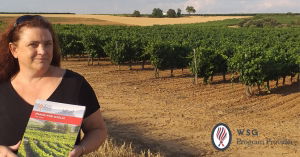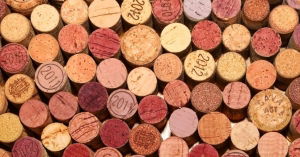BLOG
french wine scholar
Meet Jeni Wilson, founder of Vintage Class in Aranda de Duero, first wine school to launch the French Wine Scholar® in Spain!
Their first FWS is scheduled to begin January 22th 2020, more information and registration HERE.
Vintage Class will also offer the Spanish Wine Scholar® in 2020!
Could you give us a bit of background on your personal and/or professional history in wine and what made you decide to move into wine education?
Meet Julien Boulard aka "Zhulian", one of China's most well-known French wine professionals with over 40,000 followers on Weibo.
We are truly thrilled to welcome Julien, a Frenchmen of passion and talent, to bring the French Wine Scholar study & certification program to Nanning and Guangzhou. The first sessions will be announced shortly on Zhulian Wines' Weibo page.
Q1. Julien, give us a brief background on your history in wine and your wine school
After completing a Master in International Affairs (which I took because they offered intensive Chinese classes), my first job was for a wine importer located in a small Chinese city called Nanning. Well, small as in six million habitants…! The boss obviously offered me the job because I was French, and this particular feature could help bring some “authenticity” to his company. I wasn’t keen on being just a white face who could speak Chinese, so I decided that I had to study wine to add another string to my bow.
Sharon McLean is a Certified sommelier, DipWSET and Approved French Wine Scholar Program Provider at her firm Cru Consultancy, which she owns and operates with her partner, Treve Ring.She is also the Lead Instructor for the Wine Scholar Guild’s Live Online French Wine Scholar course series, an MW candidate, freelance wine writer and international consultant!
Sharon, given that we couldn’t fit all of your accolades and projects into that introduction it’s safe to say you are one incredibly busy woman! How do you fit all of this in? And... how did you start your wine journey?
An Interview With WSG's Newest French Wine Scholar Program Provider
We were recently lucky enough to add a fantastic Belgian school to our global French Wine Scholar Program Provider network. Sybille Troubleyn of Winewise in Antwerp tells us in this interview about how she got into wine, why she feels the French Wine Scholar program is a great addition to a WSET education provider's repertoire and how her school and the style of education they offer to wine students in Belgium is unique.
1) What type of education experience do you provide at your wine school that sets you apart?
We offer international wine qualifications and "Keep Up" sessions for wine professionals...
Let's face it: Bordeaux is struggling. A recurring theme during my latest visit was producers lamenting declining sales, despite their wines tasting rather delicious. In January, the Gironde Chamber of Agriculture reported that more than 1,320 winegrowers were facing financial challenges – a situation that prompted the agriculture ministry to allocate €57 million to support the uprooting of nearly 10,000 hectares of vines in the region.
Congratulations to Karen Rasmussen, FWS, for passing the French Wine Scholar exam with highest honors!
About Karen:
I am a wine professional with 10 years beverage industry experience in Denver, Colorado. In 2013, I caught the ‘wine bug’ working in a local wine shop and
North vs. south
For over a century, the unanimity of the Champagne region has been called into question. Separated by departmental lines (départements being administrative regions in France), the Côte des Bar in the southern Aube department was often considered as that distant cousin who always embarrasses themselves at parties. The big houses of “mainland” Champagne in the northern Marne department did indeed buy loads of grapes from
Wine Scholar Guild Education Director, Lisa M. Airey, CWE, FWS was knighted by the French government in a ceremony at the Embassy of France in Washington DC on March 28, 2018.
She was inducted as “chevalier” to the Ordre du Mérite Agricole for her contributions to French agriculture (namely, wine!).Sylvain Maestracci, Agriculture Counselor, officiated. It was his first knighting ceremony and hard to tell who was more touched as the medal got close to the lapel.Lisa was commended for the development of the French Wine Scholar Program which is now taught by over 50 program providers, in 53 cities, in 16 countries on 5 continents. It is also hosted as an online program in independent- and instructor-led formats.
Summary:
The vineyards of the Loire Valley follow the twists and turns of France's longest river, from the Atlantic coast to the Paris Basin. The region boasts the largest number of French white wine AOCs and also produces increasingly sought after reds. This webinar will explore the distinctive terroirs that define the grapes of each sub-region, look at the historical context and present winemaking trends that define
Every wine appellation in France has a cahier des charges, a set of regulations that delineates the production zone and specifies viticultural practices and production standards.
In many instances, a single cahier des charges references one zone of production and multiple wine styles within it (e.g. Lirac red, white, and rosé; Rasteau dry red, plus red, white and rosé Vins Doux Naturels). Some single cahiers also incorporate complementary geographic denominations or dénominations géographiques complémentaires (DGCs) such as Languedoc Montpeyroux or Bourgogne Hautes Côte de Nuits. Other times, very different wines can be grouped under one single cahier as is the case for Beaujolais, Beaujolais Supérieur, Beaujolais + Named Commune, and Beaujolais-Villages.
Congratulations Matt Coleman, FWS for passing the French Wine Scholar exam with honors! Matt Coleman is General Manager and Sommelier at Crossings Restaurant in South Pasadena, CA. Matt is pursuing his wine education with the
WSG is proud be the first Educational Partner of The Old Vine Conference. Read more to find out how this dynamic non-profit organization is actively creating a global network of old-vine disciples while raising awareness through education.
The economic and social relevance of old vines is real, but the structure of the global wine industry stacks the odds against the regenerative commercial viability of old vines. The result is that healthy old vineyards of cultural resonance and unique qualitative potential are lost because they can’t be made to pay.
The Old Vine Conference is a non-profit organisation whose aim is to bring together a global network to create a new category for wine from heritage vineyards. The Old Vine Conference works to safeguard old vines of cultural and ecological value by connecting, educating and inspiring the global wine industry through conferences, research, partnerships, tastings and fieldtrips.
On the surface, promoting Beaujolais’s best vineyards to premiers crus might appear entirely beneficial for the region. But the situation is more complex than it looks, says Beaujolais expert Natasha Hughes MW.
As part of a partnership between Wine Scholar Guild and Decanter, we are pleased to share with our readers this article pulled from Decanter Premium. Try Decanter Premium for 4 weeks for just $1! More information HERE
Robert Parker says a 100-point wine should be ‘as exceptional as a particular wine can be: a perfect blend of power, richness, texture, depth, length, balance, freshness, and of course a reflection of its vintage and terroir or origin’.
Here are Parker’s most memorable 100-point wines.
“You always remember Pécharmant,” observes Benoit Borderie of Château Poulvère. “Once you've tried it, you seek it out.” This niche French wine is not quite famous, not entirely secret, but what the French call "confidential."
On a blistering June day, my suitcase rattling over the hot cobblestones, I made my way by through the village of Amboise in the Loire Valley, where my tour with the Wine Scholar Guild was about to begin. That night, in an 18th century hotel decorated in a style my spouse describes as “manic grandma,” the group toasted our safe arrival and talked about what had brought each of us there. Though we were a diverse set—with wine professionals from all over the map, and a handful of enthusiasts outside the industry—we all seemed to agree on one thing
Earlier this year, I embarked on the French Wine Scholar (FWS) program; version 7 being the latest update to this ever-popular certification offered by Wine Scholar Guild to wine enthusiasts and professionals alike. Here are my top study tips for passing the French Wine Scholar program!
Watch Here
You can find this video in our community space here
Summary
What comes to your mind when you think about Bordeaux? Is it carefully manicured fairytale Chateaux of the left bank? The 1855 classification? The First Growths? These prestigious wines garner much of the attention, but only
Where to Watch
You can watch this tasting video in our community space here
Summary
Poulsard, Pinot Noir and Trousseau make up the trio responsible for the best red wines of the Jura. One of those is probably familiar to you, but the other two are firmly off the beaten track!
Watch Here
You can find this recording in our community space here
Summary
In this month’s Icon tasting, I get to try one of the Northern Rhone superstars, Domaine JP Jamet’s Cote-Rotie from 2011. It got me thinking about what it takes to elevate a




















